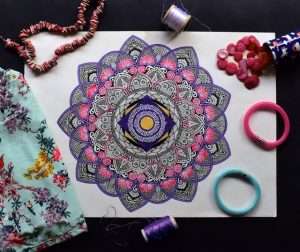As an avid art collector, I was recently asked to give a talk at my local church on the benefits of collecting art. The following is a summary of my presentation.
As many of you know, I have been collecting art for over 30 years and have built a collection of over 2,000 pieces. I have received a number of questions from people in the community, who are curious about my passion for collecting, wondering if there is an opportunity to share with others some of the benefits that collecting has given me.
Art lovers all over the world feel that art plays a significant role in their lives and are involved in this passion for one reason or another. My own personal journey into the world of art began when I was about eight years old and started taking violin lessons. At the end of every lesson I would be given as a reward a print of a famous painting. This happened with such consistency that I developed an appreciation early in life for art and felt an urge to become involved with it in some way.
The first piece of original fine art that I ever bought was a watercolor by Samuel Colman while still in college. From then on, my passion grew rapidly and it soon became evident to me that this was something that I wanted to continue doing throughout my
Art is pleasure. Art connects people. Art is the beginning of civilization. The list goes on and on. Collecting art is perhaps the purest expression of the joy that comes from choosing to surround yourself with beauty, and the tradition of appreciating art by collecting it dates back to ancient Egypt.
In today’s fast-paced world, where everything seems to be a race to see who can do things quicker, we often forget how important it is to take time to enjoy life and admire the amazing things that people have created.
With such a rich history behind it, there is no reason not to collect art now. If you’ve ever been in love with a piece of art or an artist, you know exactly what I’m talking about; if not, you are missing out on one of life’s most rewarding pleasures!
If you’re interested in starting an art collection but don’t know where to start, consider the following factors when deciding what kind of art to collect:
* Your Budget – You can collect anything if you really want it; however, if you don’t have much money available for collecting it may take longer than you’d like before you build up a nice collection. In some cases your budget will determine what kind of artwork you’ll be able
Art collectors often get a bad rap. Many people think that they do it as a status symbol, and simply buy art as an investment. The truth is that most people who collect are doing it for love of the piece, not for the value of the piece. There are, however, many reasons to start or continue collecting art.
Art can be an investment in itself. If you spend a lot of money on a piece of art and then put it in the right place, it can bring you back more cash in the future. This is true more often than you would think, but you must do your research and make sure you know what you are buying before you purchase anything.
You can also purchase art to help promote your business. Most galleries will let you put up advertisements so customers can take flyers with them when they leave. You want to get your name out there anyway, so this might be a good investment to make on some pieces of art.
This process can also work in reverse: if someone sees your art and likes it enough to ask about it, this can lead to new business and therefore make your original investment worthwhile.
You have probably seen artwork using words created by using letters from different pieces of writing or different languages. This type of
Art is an investment that pays off in multiple ways. There are many ways to collect art, from buying the work of a living artist whose work you admire, to purchasing modern and classic masterpieces from established galleries and auction houses. Whether your collecting goals are for personal enjoyment or for profit, there are plenty of positives to be derived from collecting art.
Buy Art for Fun
While it’s true that art can also be a smart investment, don’t think that you must have investment goals in order to buy art. You can buy art simply because you enjoy it, whether or not it appreciates in value. Buying art for fun is often the best way to start your collection and learn the ropes of how things work. Art can be a very enjoyable hobby and you should never feel pressured into collecting if you don’t want to or if it isn’t right for you.
A lot of people enjoy collecting art as a hobby. They get immense pleasure out of choosing new additions to their collections and discovering what goes well together in their homes and offices. Many collectors choose to build collections around themes or topics that interest them such as different artists’ interpretations of the same subject or pieces from a particular time period. This kind of focused collection can be very rewarding.
An art collection is a piece of art in itself. It can also be a financial investment, or a way to satisfy your inner collector, or both. Art is a good investment because it is not subject to the whims of the economy.
You may be thinking that art as an investment is only for the wealthy, but this is not true. Art can be acquired at any price point and still offer returns; it just depends on what you’re looking for and how much you want to spend.
In addition, if you buy art that you like and that you think will appreciate in value, you are enjoying your art collection now and watching it grow at the same time. And if your tastes change over time, then you can sell some pieces and replace them with new ones that appeal to your current tastes.
Art collecting is a great way to invest in the best, most valuable works of art. Why? Because you can choose from any type of art you want, from almost any era and style. You can mix and match as well, adding variety to your collection and even imitating the collections of famous people.
Truly great art has only appreciated in value over time. That means that a work you purchase today will likely be worth more than when you first bought it. Most investments lose their value over time due to inflation, so if you want an investment that will keep its value you should consider getting into the art market.
It’s also possible to buy larger pieces of art rather than many smaller ones. This allows you to decorate your home with a single piece of artwork instead of a number of smaller ones, giving your home a more cohesive feel.
You also have the option of selling your entire collection at one time if you need money or would like to change your taste in art. This is not something that other types of investments allow for, so it’s another perk to buying art for your portfolio.
Another reason why investing in art can be advantageous is because there are no fees or commissions associated with buying and selling art like there are with other financial accounts
The art market is an illiquid one, meaning that it takes a long time to buy and sell pieces. This illiquidity has its benefits: the art market is not as volatile as other financial markets, because buying and selling pieces takes time.
But this also means that you have to be in it for the long haul. When you start out collecting, you’re going to have to build up your collection slowly.
As you’re starting out, keep in mind that cultivating relationships with dealers and artists can help you along the way. Many dealers will have works by emerging artists in their galleries that are available for pre-order at discounted prices. And talking to the artist can give you an idea of what kind of person they are and how seriously they take their craft—which can be an indication of the quality of their work.
However, even if you start small, don’t forget that having a collection of art can help diversify your investment portfolio. The art market tends to be less volatile than financial markets, which makes it a great investment choice for risk-averse investors.



